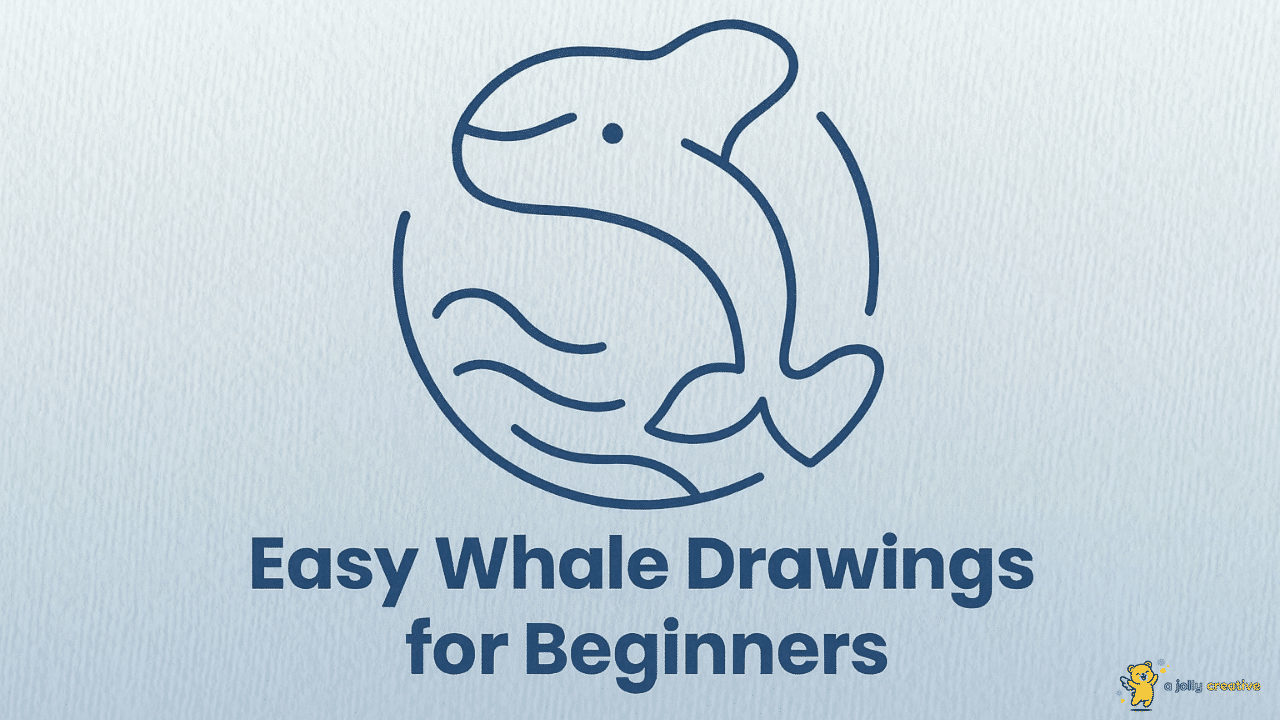Dive into the fun of drawing whales! These gentle ocean giants are super cool to sketch, with their graceful moves and calm vibes. Whether you want to relax with art or fill your sketchbook with cute sea creatures, whale drawings are a perfect way to start your creative adventure!
Whales are easy to draw with simple shapes and smooth lines, making them great for all just starting out.
Even a quick whale sketch looks amazing and makes everyone smile. Plus, drawing these peaceful creatures is super relaxing and helps calm your mind.
Grab a pencil and let’s make some whale-tastic art!
Super Simple Whale Drawing
The simplest whale drawing requires just three curved lines that create instant recognition. Start with a gentle arc that forms the whale’s back, then add a smaller curve underneath for the belly. These two lines already suggest a whale’s basic form.
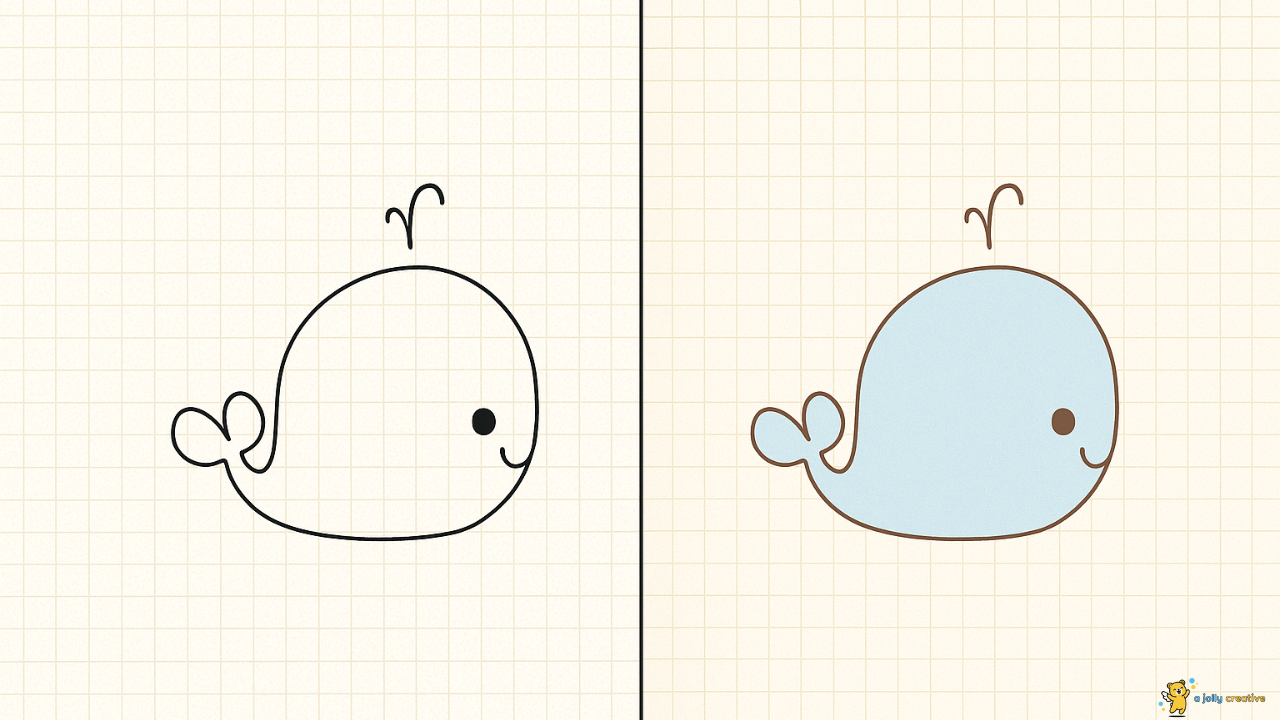
Adding personality happens through eye placement and expression. Eyes positioned slightly forward on the head create a friendly, approachable whale. A tiny curved line below the eye suggests a gentle smile that makes viewers feel happy.
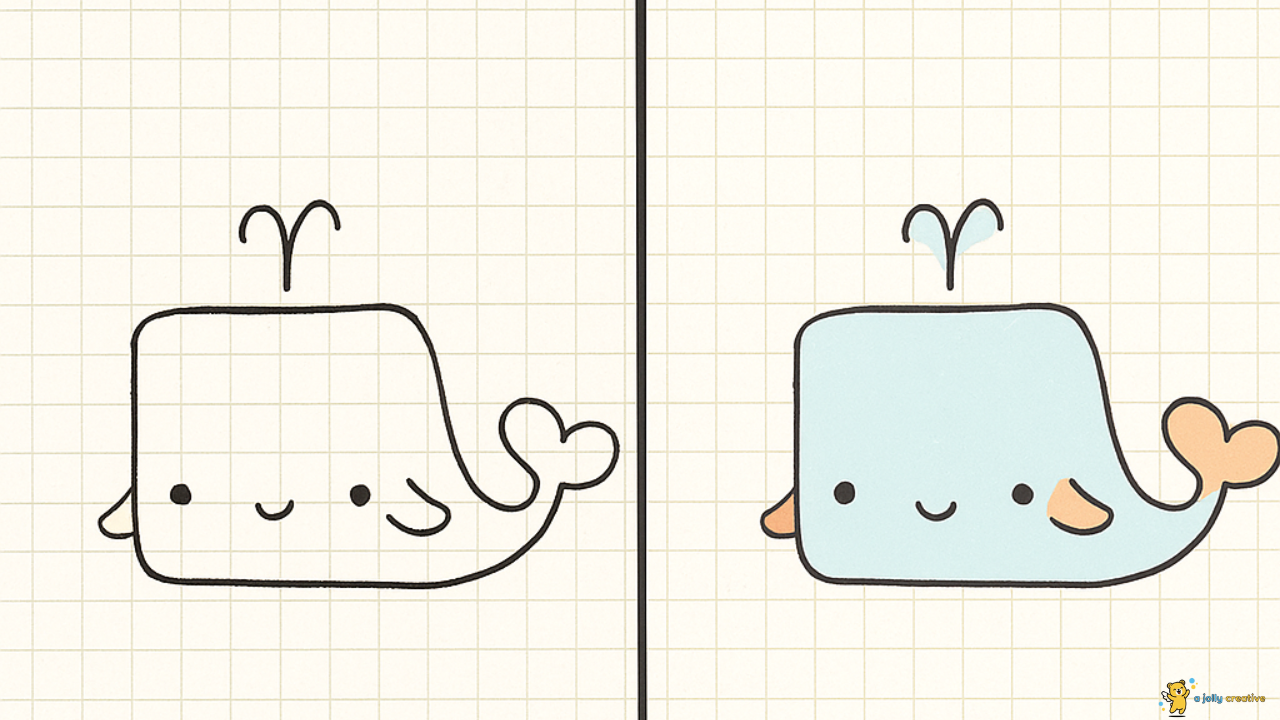
The tail fluke completes your simple whale with a heart-shaped addition at the body’s end. This iconic whale feature immediately identifies your drawing as a whale rather than just any fish.
Dreamy Fantasy Whales
Dreamy whale drawings capture ethereal qualities through soft textures and flowing lines that suggest magical underwater realms.

These whales often appear to float through clouds rather than swim through water, creating artwork that feels both peaceful and otherworldly.
You may also like to read: 25 Cute and Easy Sheep Drawing Ideas
Blue Whale Drawing
Blue whale drawings offer opportunities to explore realistic proportions while maintaining accessible beginner techniques.
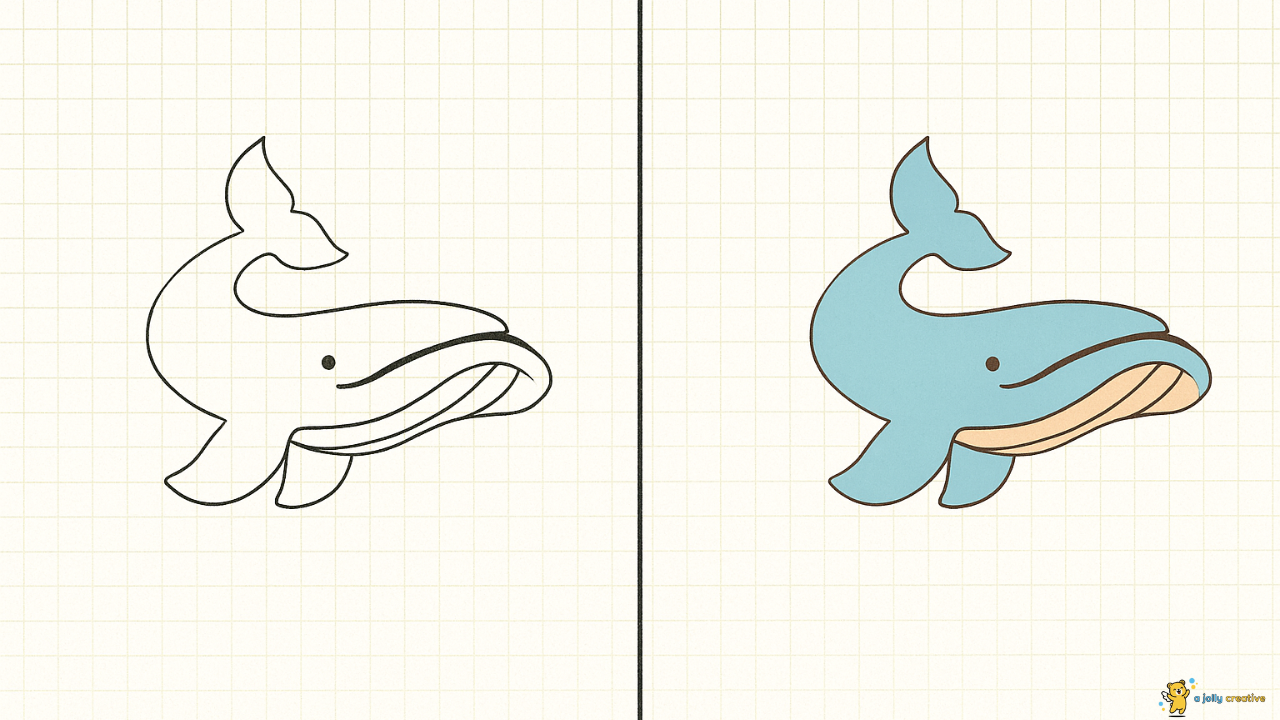
These magnificent creatures measure up to 100 feet in length, making them Earth’s largest animals ever known. Capturing their majestic scale requires understanding relative proportions rather than precise measurements or complex anatomy.
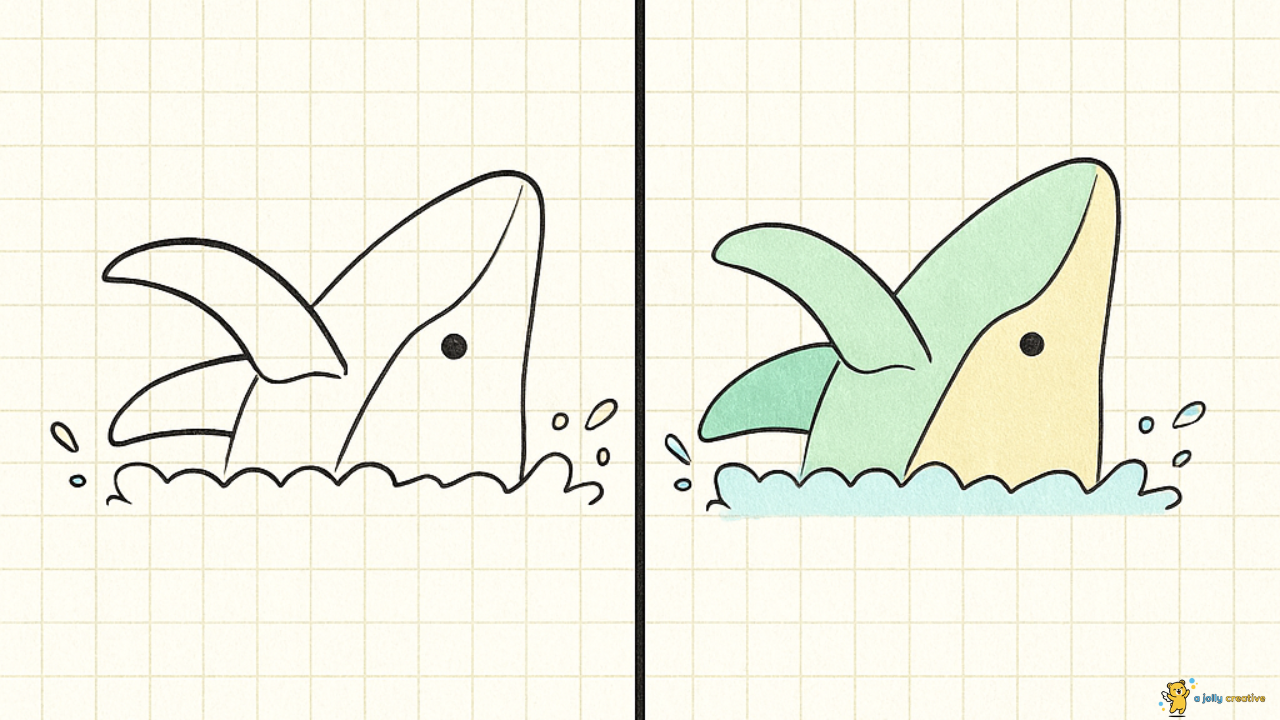
Distinctive throat grooves characterize blue whale anatomy and add authentic detail to your drawings without overwhelming complexity. These parallel lines run from the whale’s chin to approximately mid-body, creating visual texture that suggests the whale’s feeding mechanism.
Chibi Whale Cuteness
Chibi whales feature oversized heads that occupy nearly half the total body length, creating dramatic proportion shifts that generate immediate charm. This style transformation makes even massive whales appear tiny and huggable.
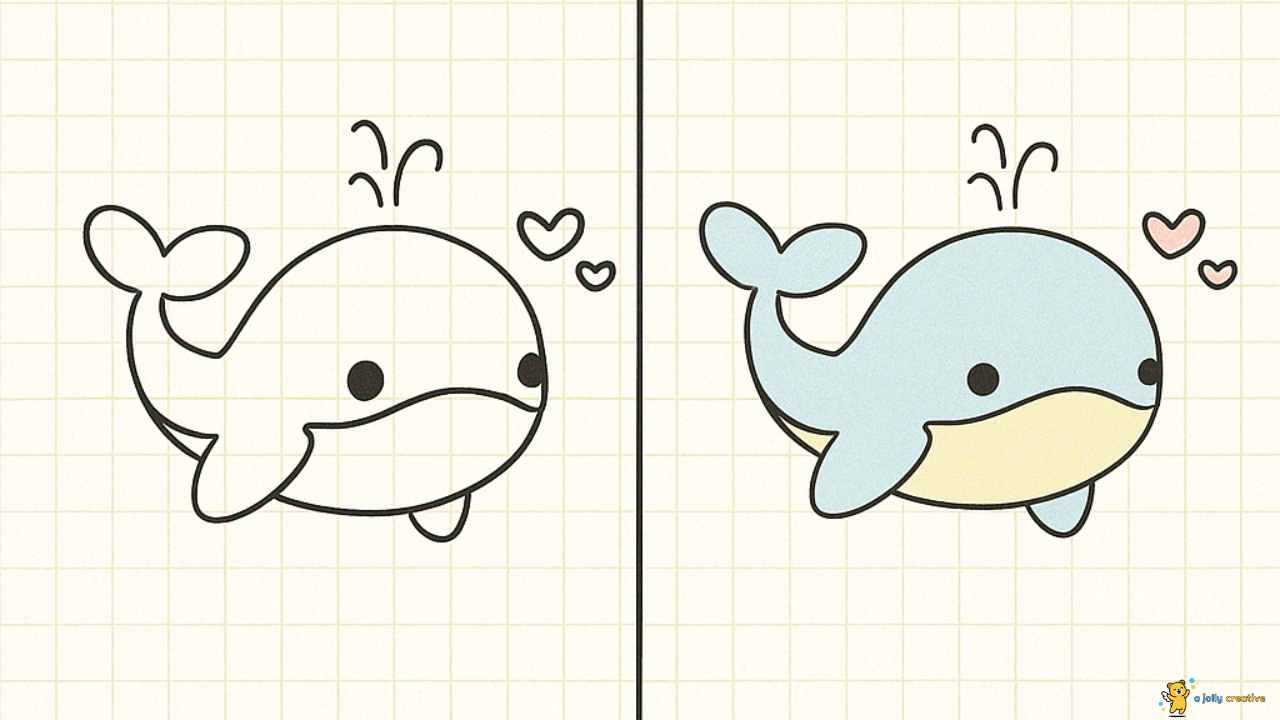
Large, expressive eyes become the central focal point of chibi whale drawings, often occupying significant head space.
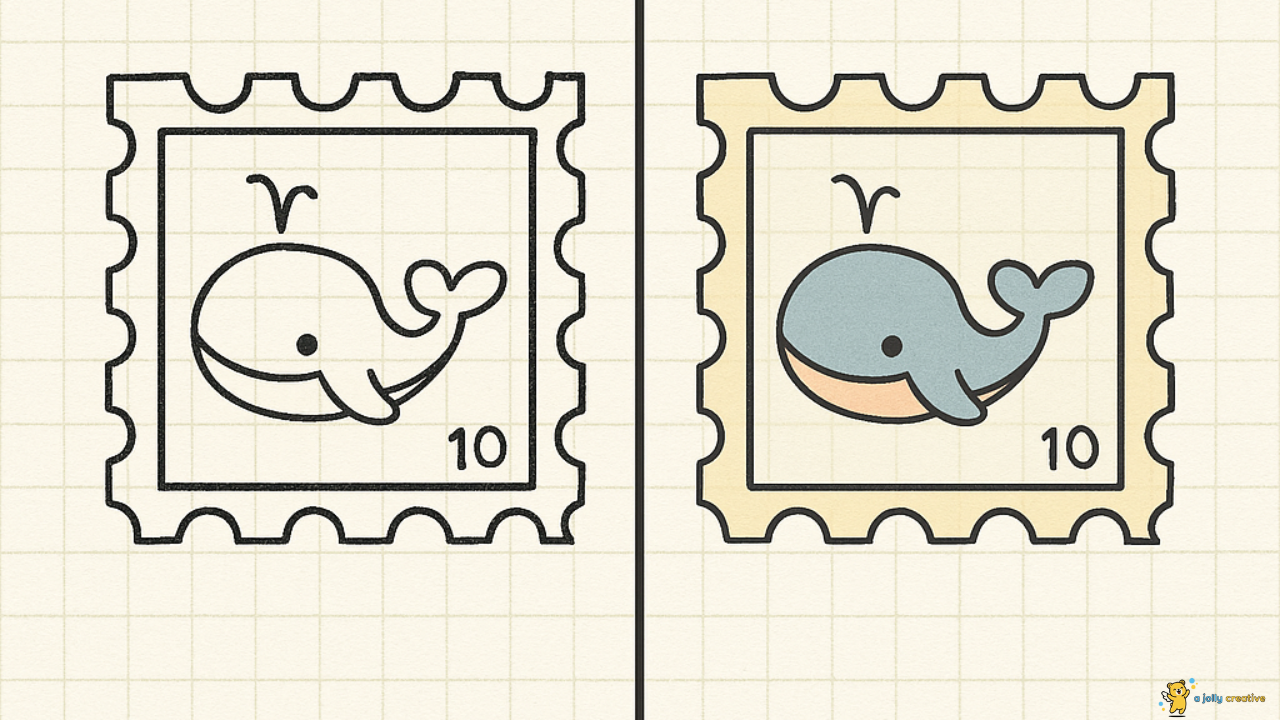
These oversized eyes typically include bright highlights that suggest moisture and life, while simple curved lines around them can suggest eyelashes or perpetually happy expressions.
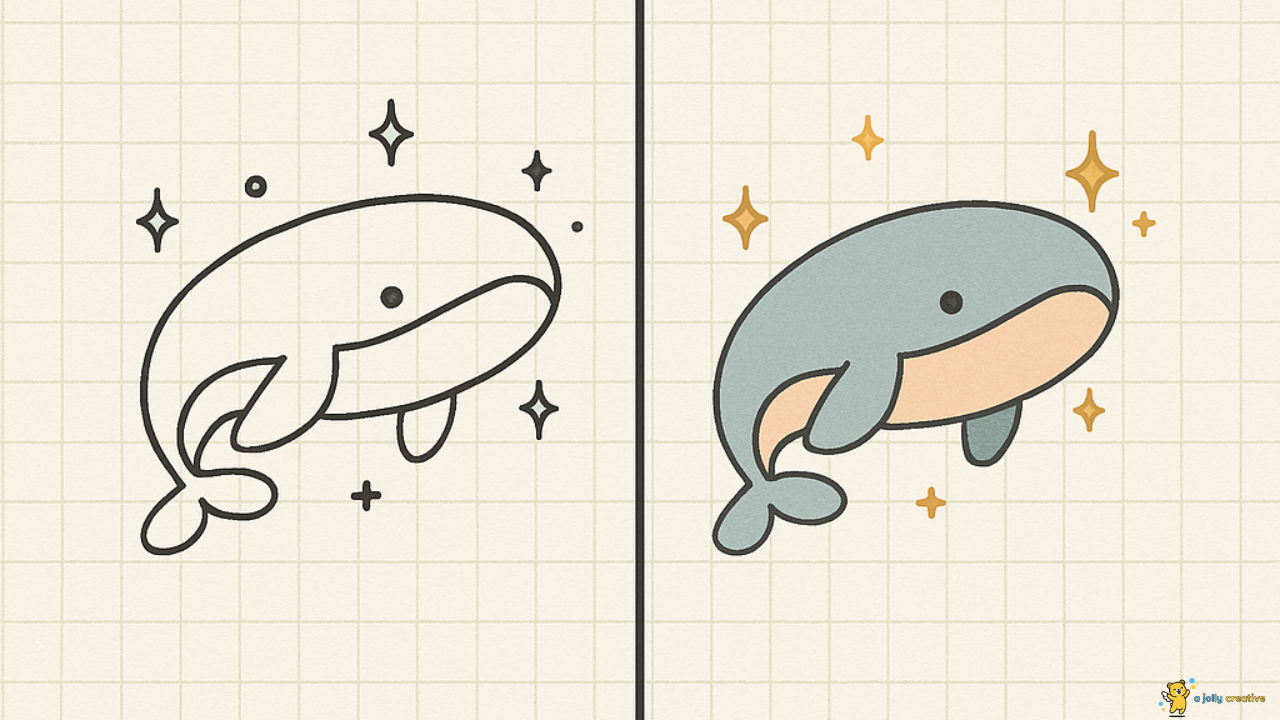
Chibi whale fins remain deliberately small and rounded rather than realistic and pointed, maintaining the cute factor while ensuring the whale appears completely non-threatening.
If you’re interested, check out: Easy Animal Drawing Ideas
Silly Whale
Silly whale drawings celebrate pure humor through wildly exaggerated expressions and delightfully playful poses.
Playful pose suggestions include whales doing handstands, juggling colorful fish, or wearing silly accessories like polka-dot bow ties or tiny top hats.
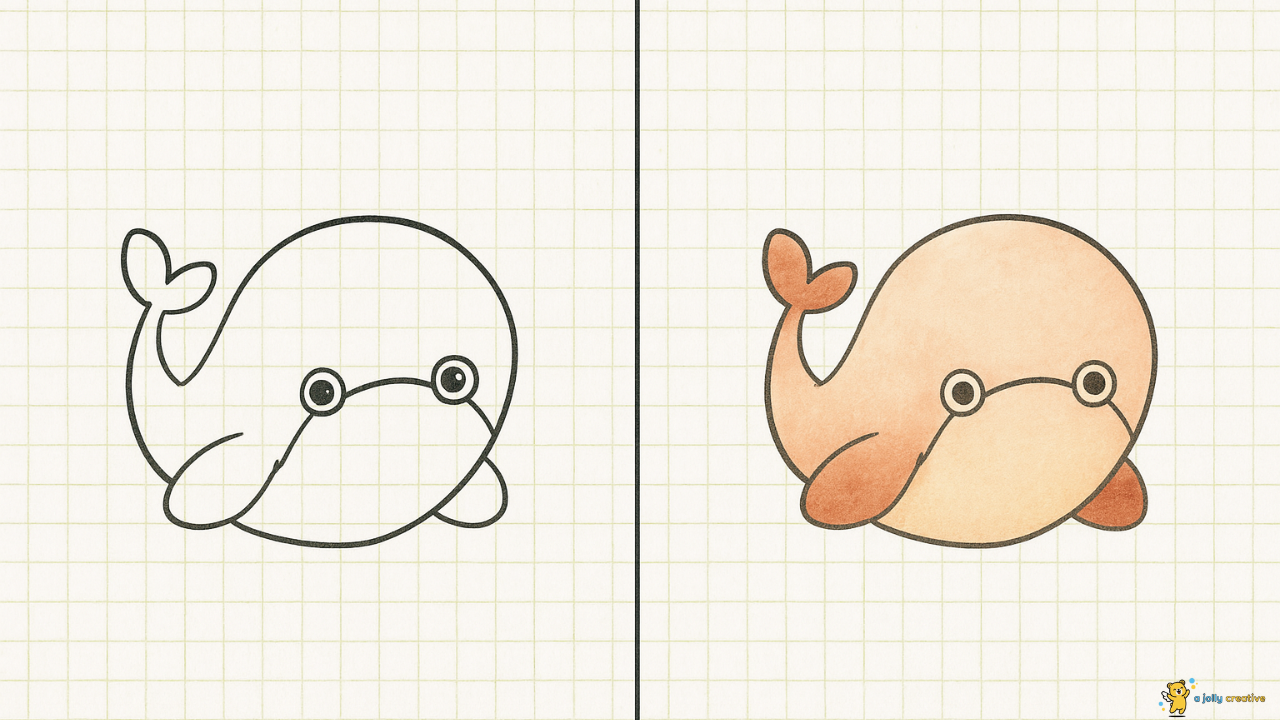
These whales might sport enormous grins, hilariously crossed eyes, or comically oversized fins that emphasize their goofy nature. Cartoon expression mastery develops naturally through experimenting with extreme facial features and poses.
Whale & Baby Families
Parent and baby whale compositions explore emotional storytelling through carefully planned visual art that touches hearts.

These drawings capture tender moments between whale families while teaching valuable lessons about size relationships and natural protective positioning in marine environments.
Narwhal Magic
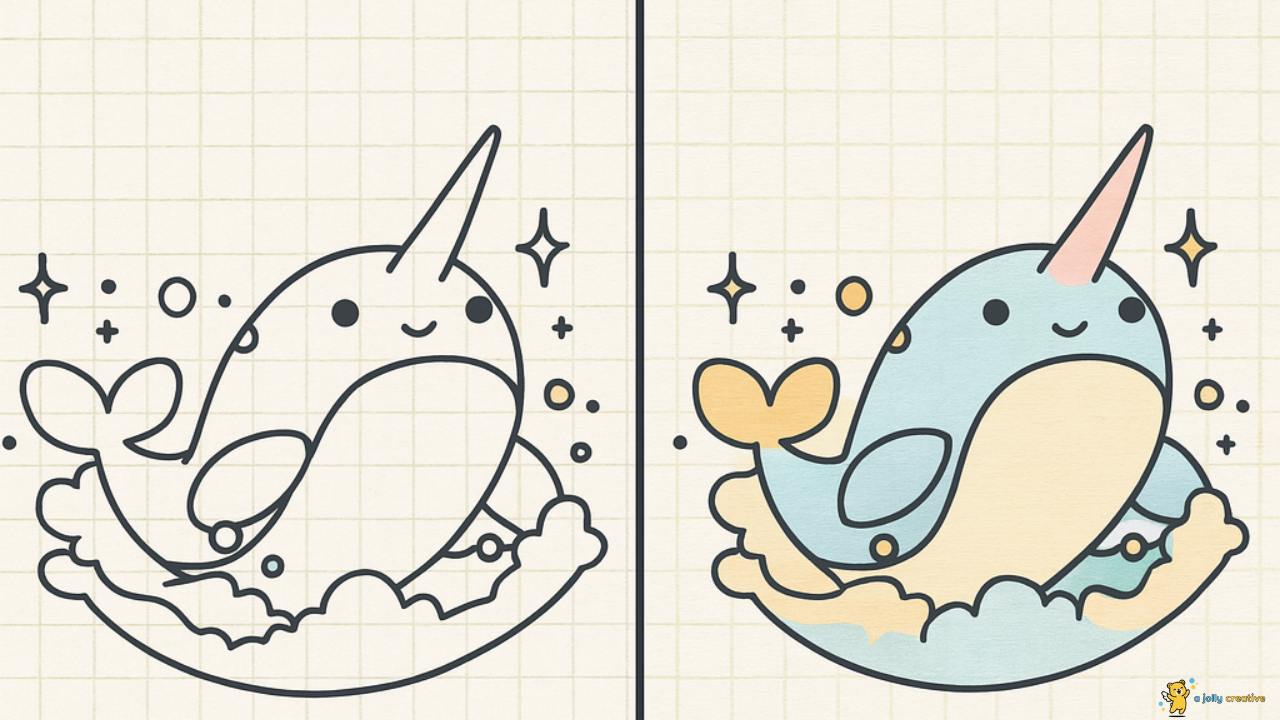
Narwhal drawings showcase one of the ocean’s most distinctive and mysterious creatures through their legendary spiral tusks that can reach 10 feet in length. These “unicorns of the sea” naturally capture imagination through their mythical appearance combined with their very real existence in Arctic waters.
Girl Riding a Whale Adventures
Fantasy whale riding scenes combine basic human figure drawing with whale illustration for magical storytelling opportunities that spark imagination.
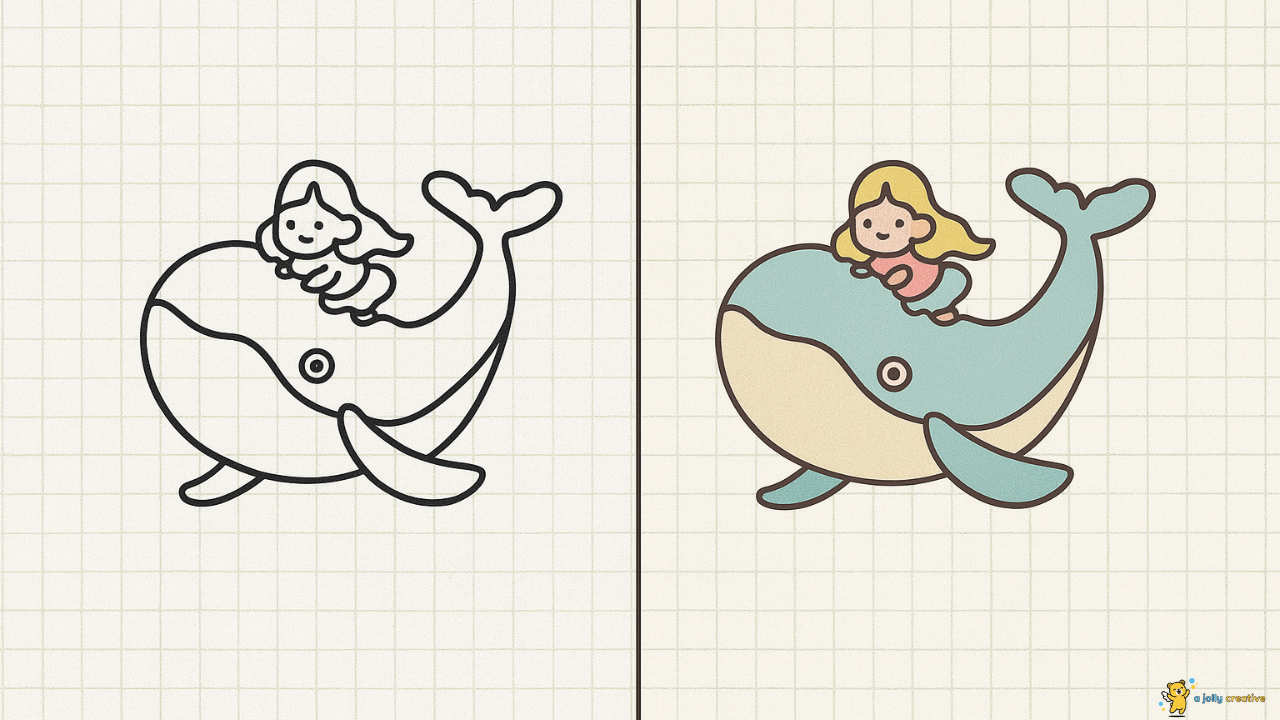
These whimsical compositions require balancing human proportions with whale scale while maintaining believable interaction between the fantastical characters.
You might find this interesting: 35+ Easy Duck Drawing Ideas
Aesthetic Whale Drawing
Aesthetic whale drawings embrace current social media trends while maintaining genuine artistic integrity and visual appeal.
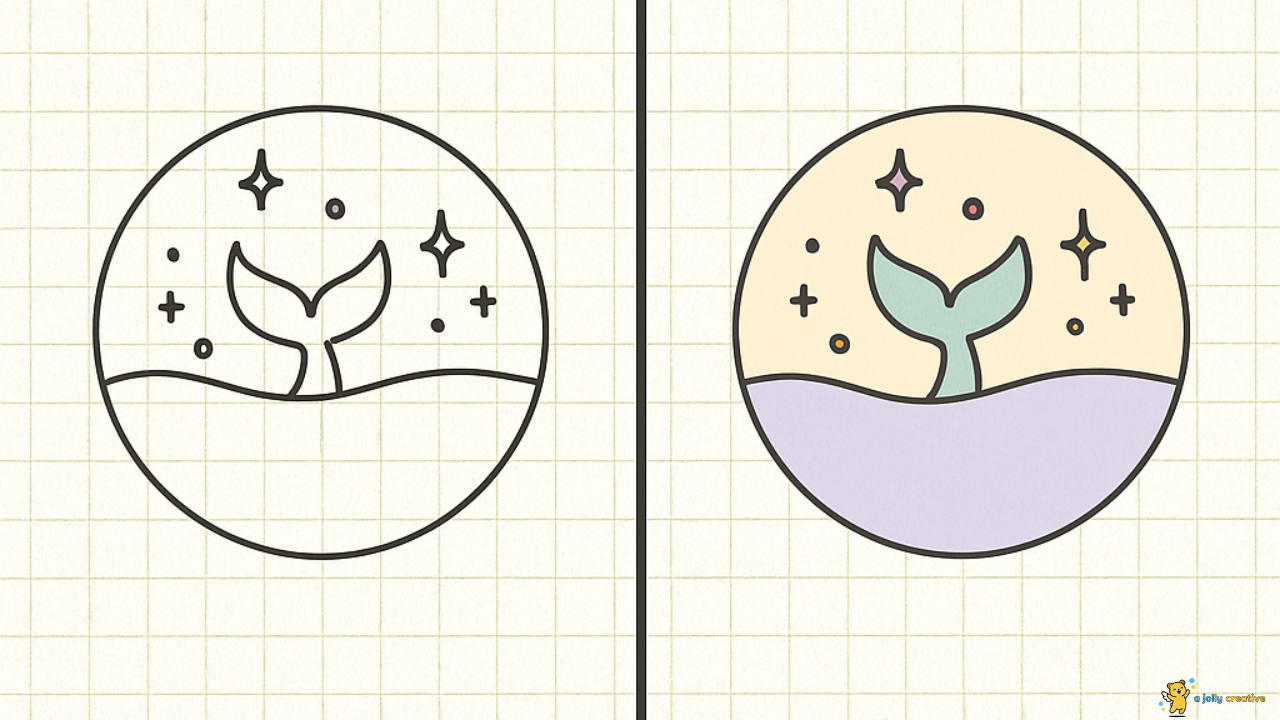
These designs often feature minimalist line work that suggests whale forms without excessive detail or visual clutter.
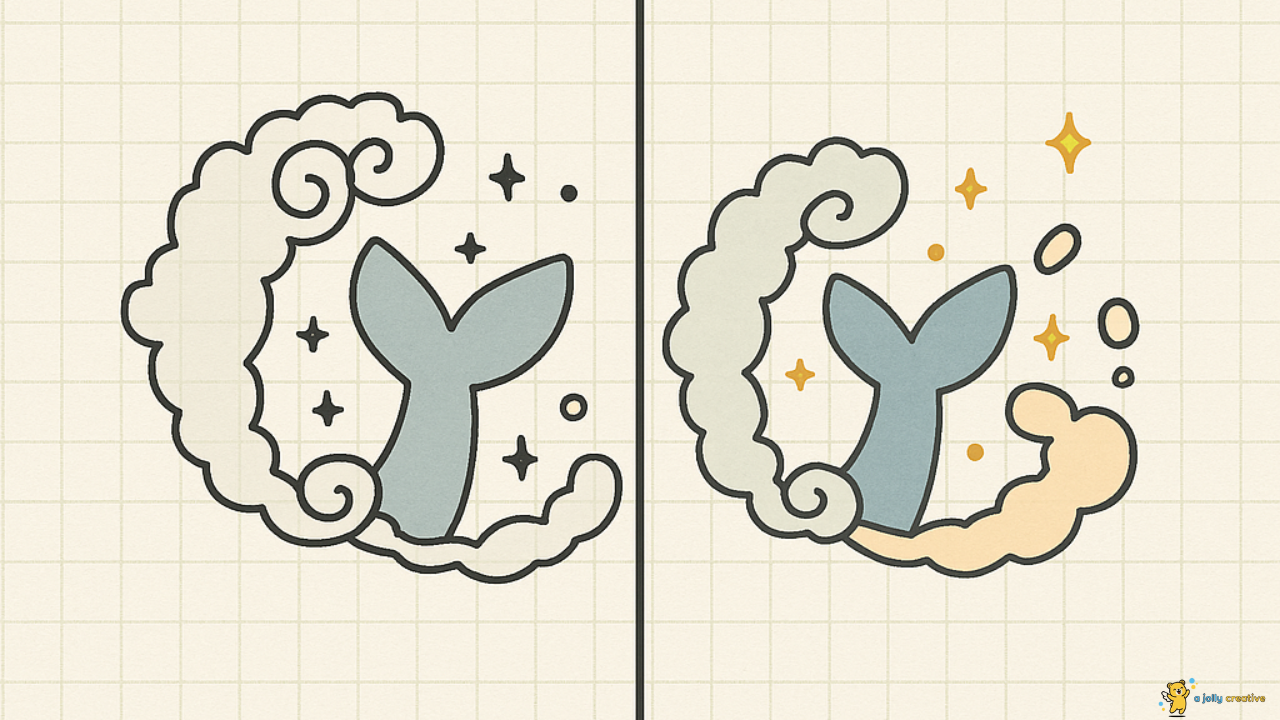
The aesthetic movement values clean, Instagram-worthy visuals that photograph beautifully and share well online.
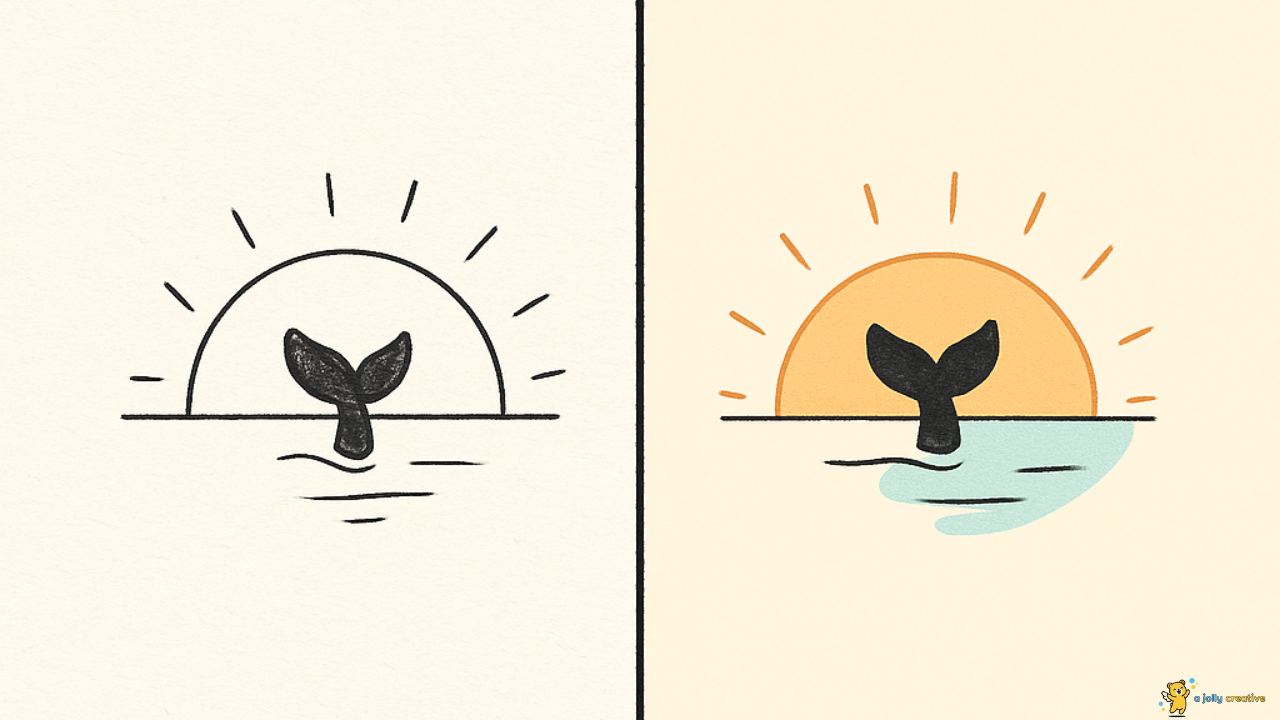
Trendy color palette choices for aesthetic whales typically include soft pastels, muted earth tones, or sophisticated monochromatic schemes.
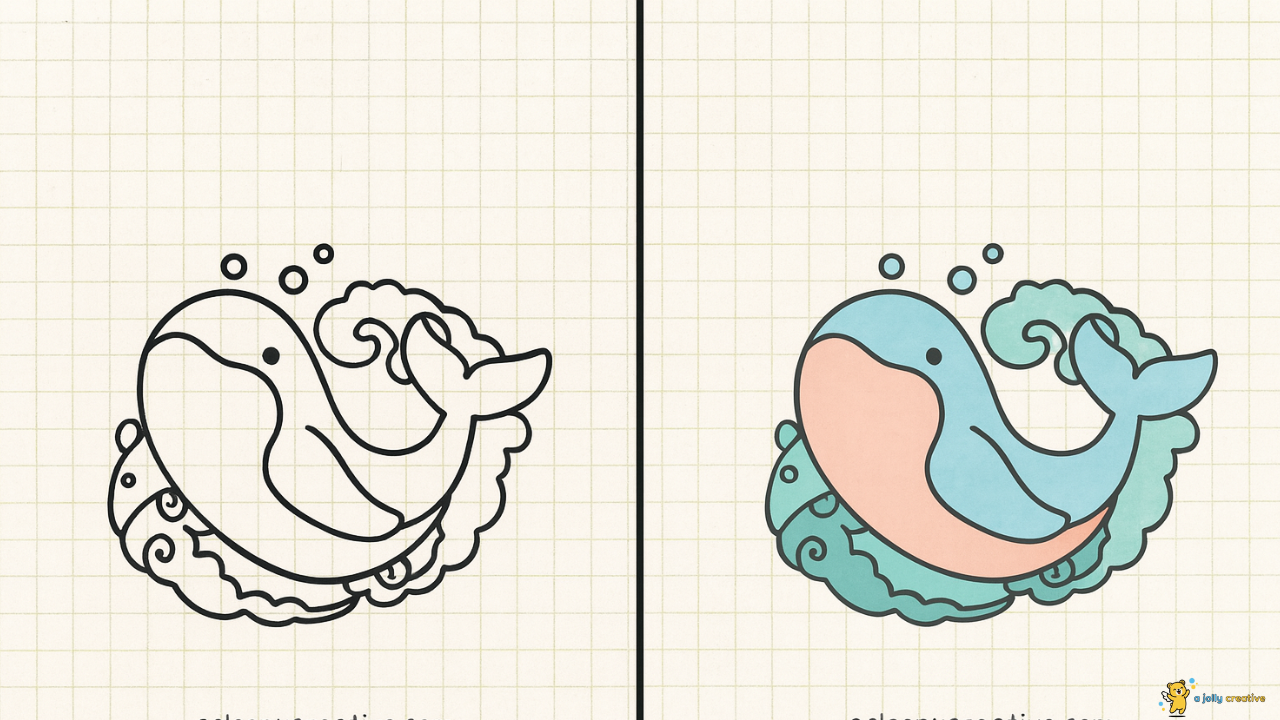
These restrained color approaches create elegant artwork that appeals to contemporary design sensibilities

while remaining timelessly beautiful and sophisticated.
Orca (Killer Whale) Power
Orcas present exciting black and white pattern challenges that teach valuable lessons about dramatic contrast and visual impact. Dorsal fin prominence characterizes orca anatomy dramatically, with male orcas sporting impressive fins reaching up to 6 feet tall.
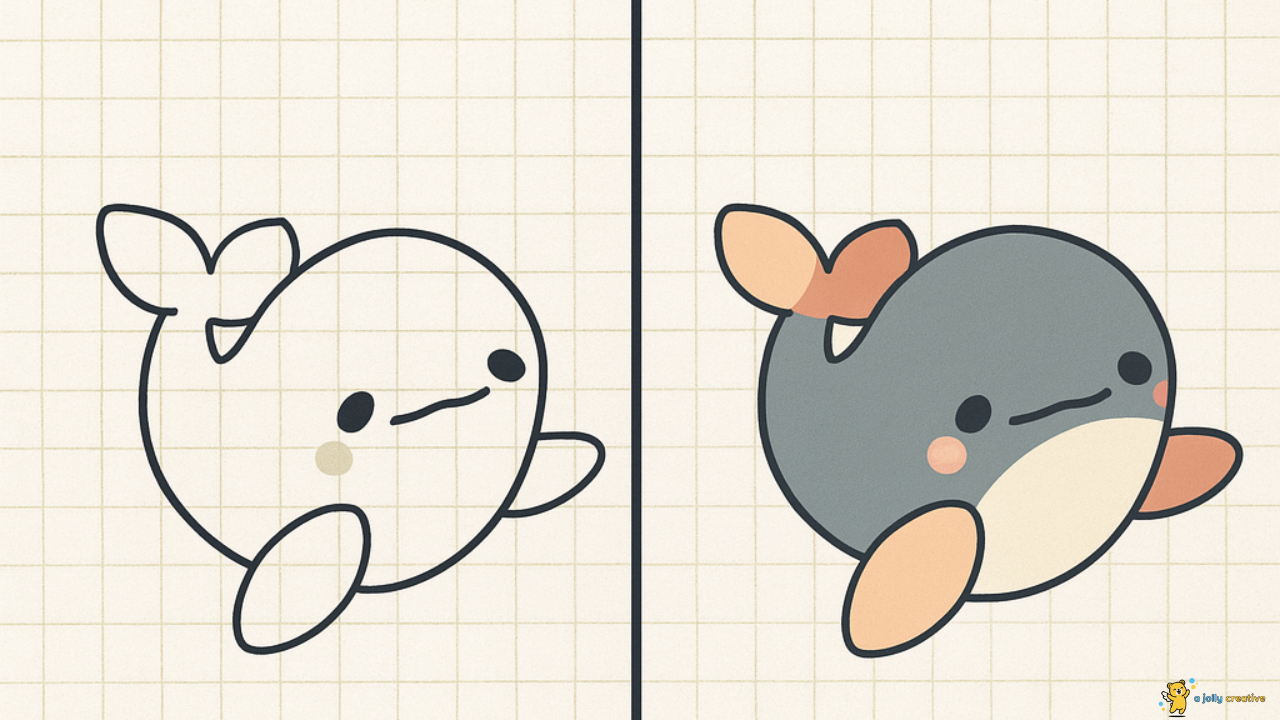
These distinctive markings follow specific natural patterns that help identify individual whales in the wild while creating striking, memorable artistic compositions.
Constellation Whale Dreams
Constellation whales combine celestial themes with marine subjects for truly unique and magical artistic expression. Star pattern incorporation can follow actual constellation shapes from astronomy or create original patterns that complement your whale’s graceful pose.
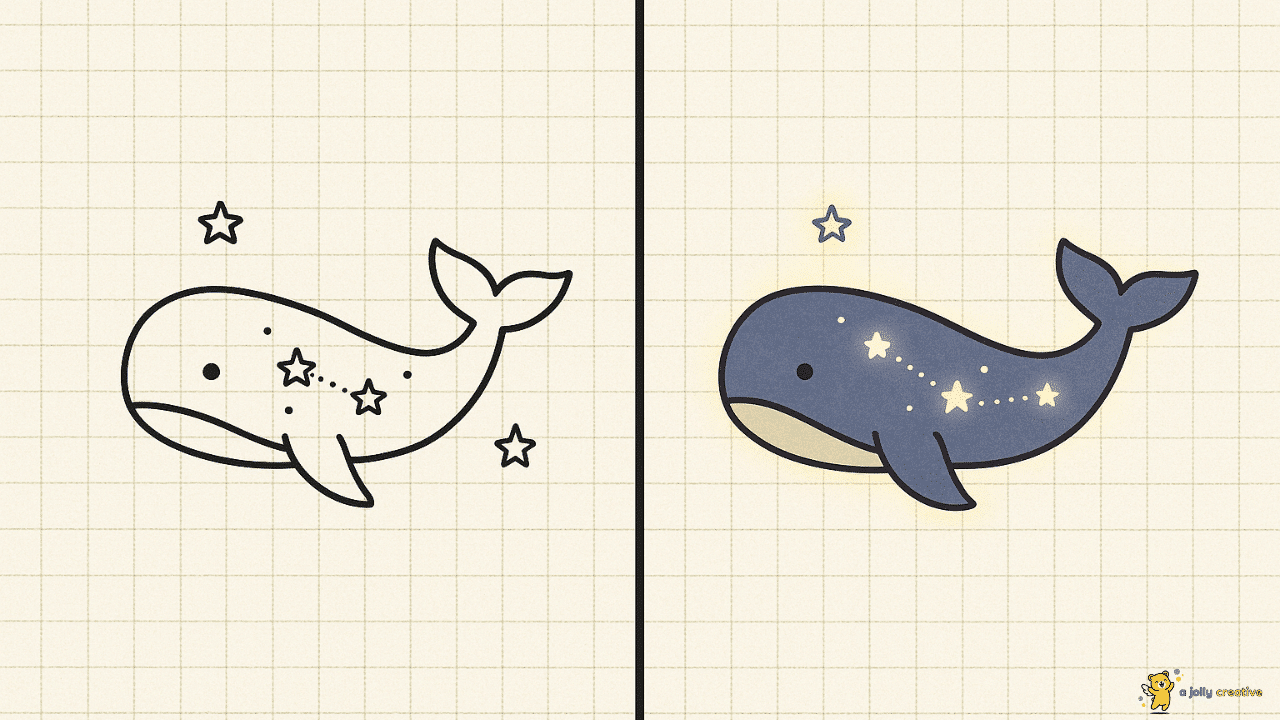
These innovative designs incorporate twinkling star patterns either within the whale’s body or scattered around it like cosmic dust trails. Dot-connecting techniques create constellation patterns that tell enchanting visual stories.
Continue on your article: 25+ Cute and Easy Dinosaur Drawing Ideas
Beluga Whale Smiles
White whale shading techniques require understanding how to show form and volume on light-colored subjects without overwhelming their characteristic pale beauty.
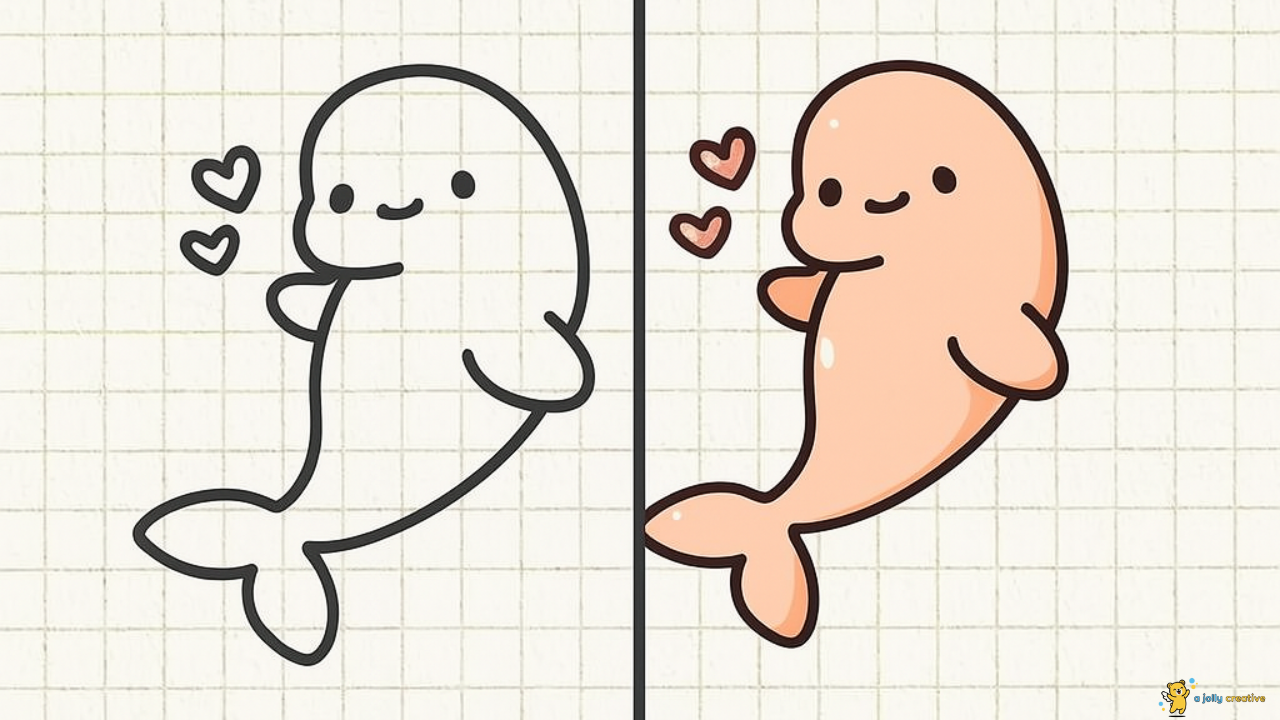
Beluga whale drawings emphasize the species’ distinctive rounded forehead called a melon, which bulges prominently above their small, perpetually smiling mouths. This unique anatomical feature immediately identifies belugas and provides an excellent focal point for your cheerful artwork.
Vintage Whale Studies
Vintage whale illustrations draw inspiration from 19th-century maritime art and classical natural history texts that documented ocean life.
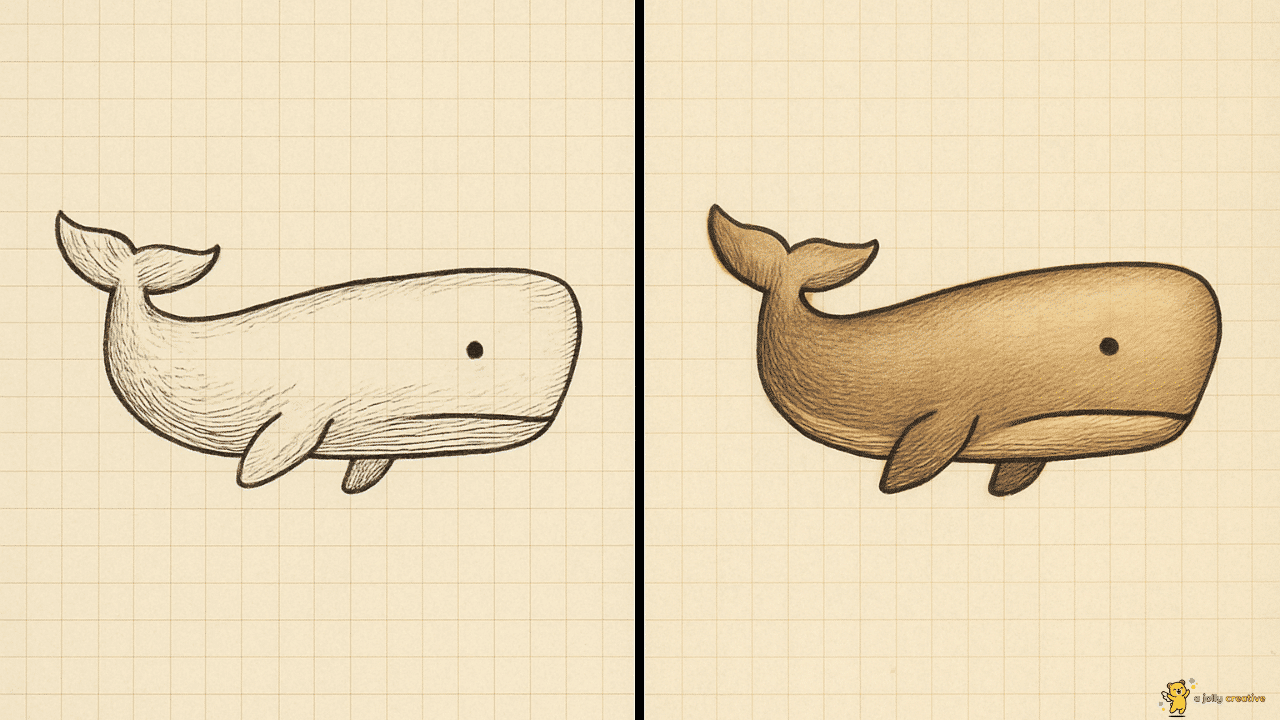
These drawings often feature traditional cross-hatching techniques, warm sepia tones, and formal composition styles that evoke historical scientific illustrations and maritime heritage.
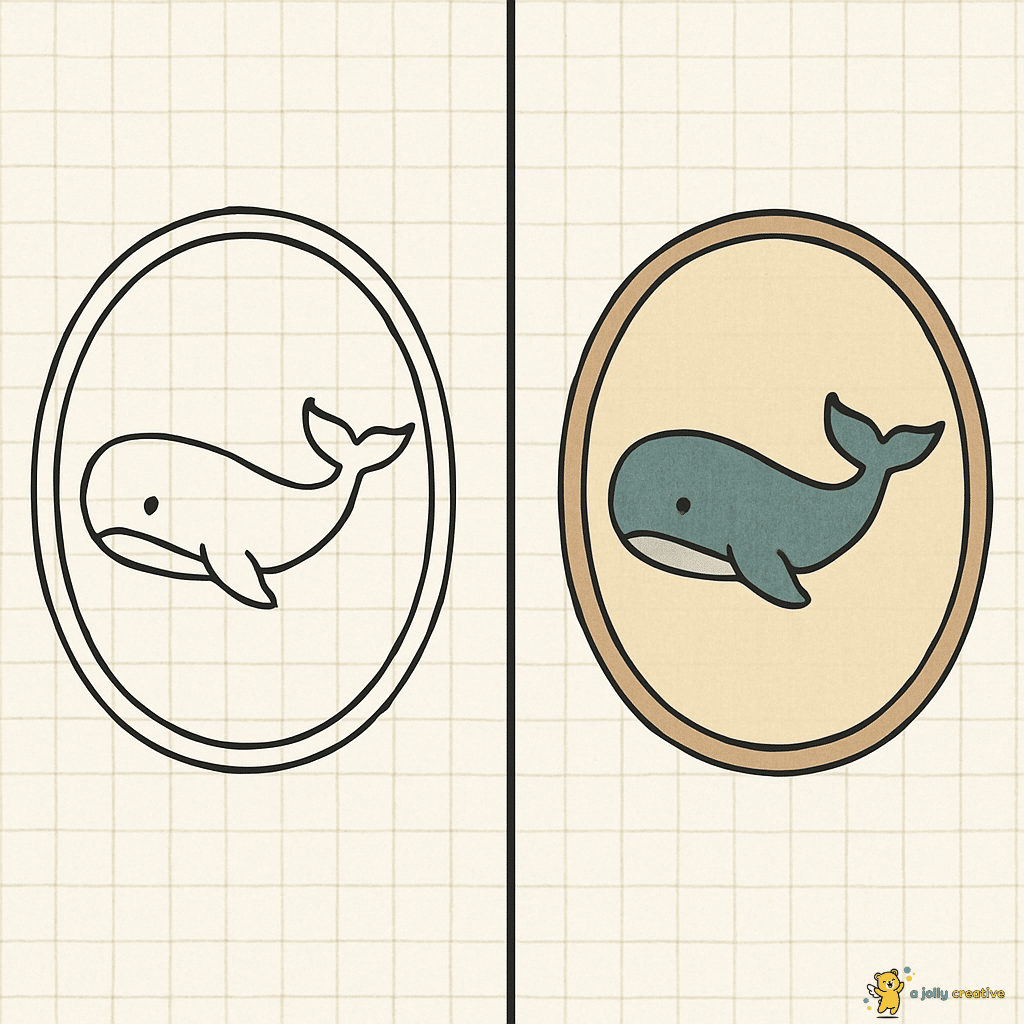
Classic illustration style emphasizes precise line work and careful attention to anatomical accuracy that reflects serious scientific study.
Sperm Whale Depths
Sperm whale drawings showcase dramatically distinctive head shapes that comprise up to one-third of their total body length, creating fascinating compositional challenges for artists.
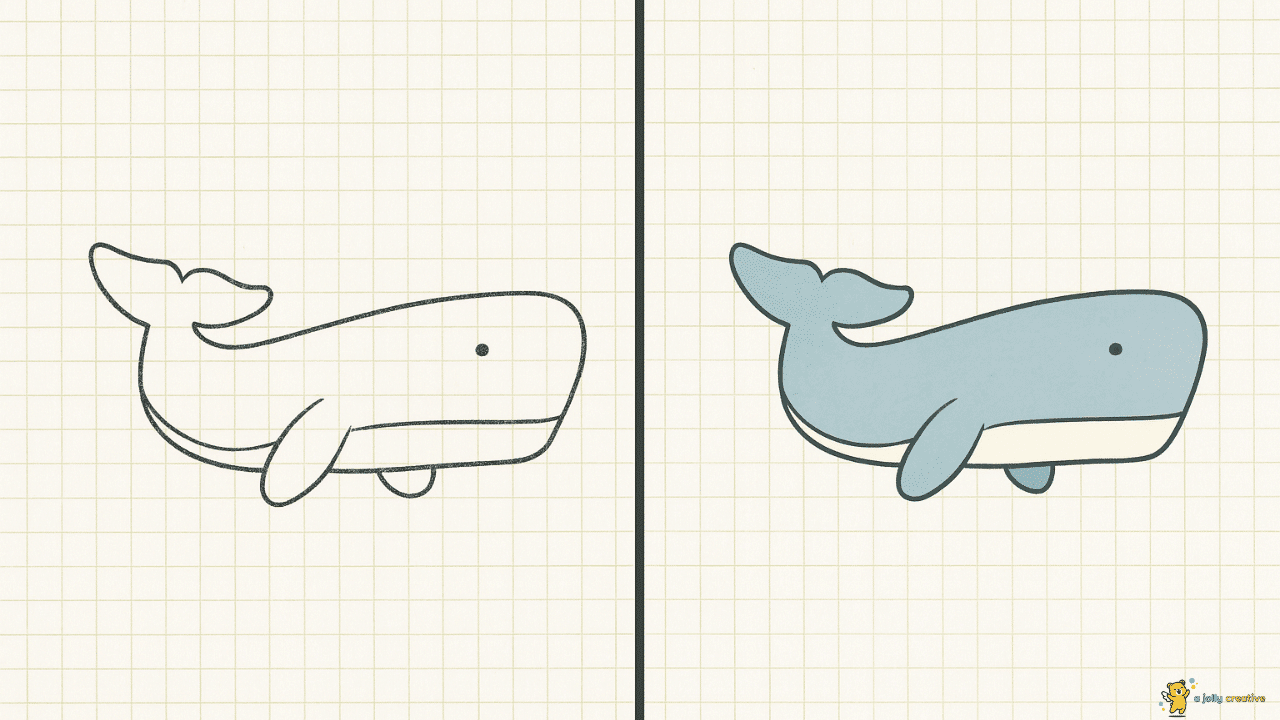
This massive, square-shaped head immediately identifies sperm whales and distinguishes them from all other whale species. The blocky forehead contains the largest brain of any animal on Earth, weighing up to 17 pounds.
Whale Shark Giants
Whale shark drawings require important clarification since they’re actually filter-feeding sharks rather than true whales, despite their enormous size and gentle nature.
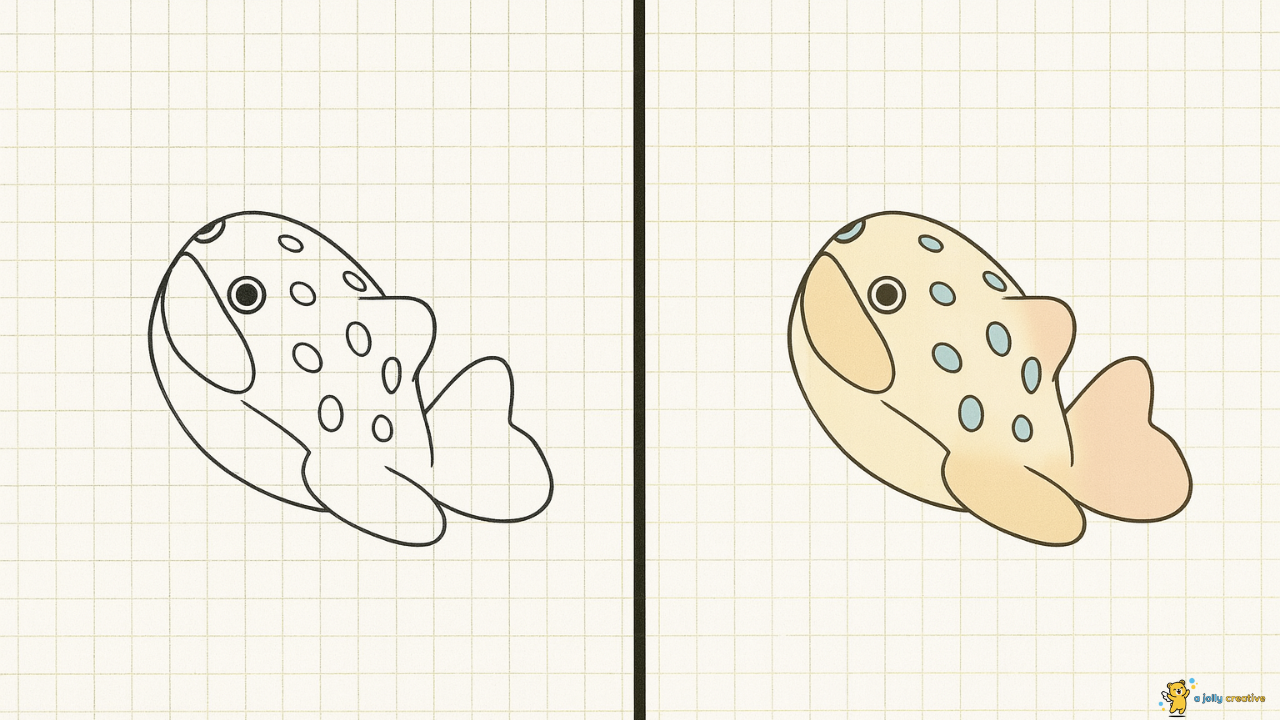
These magnificent creatures can reach lengths of 40 feet and display beautiful spotted patterns that create excellent drawing practice for texture work and pattern repetition techniques.
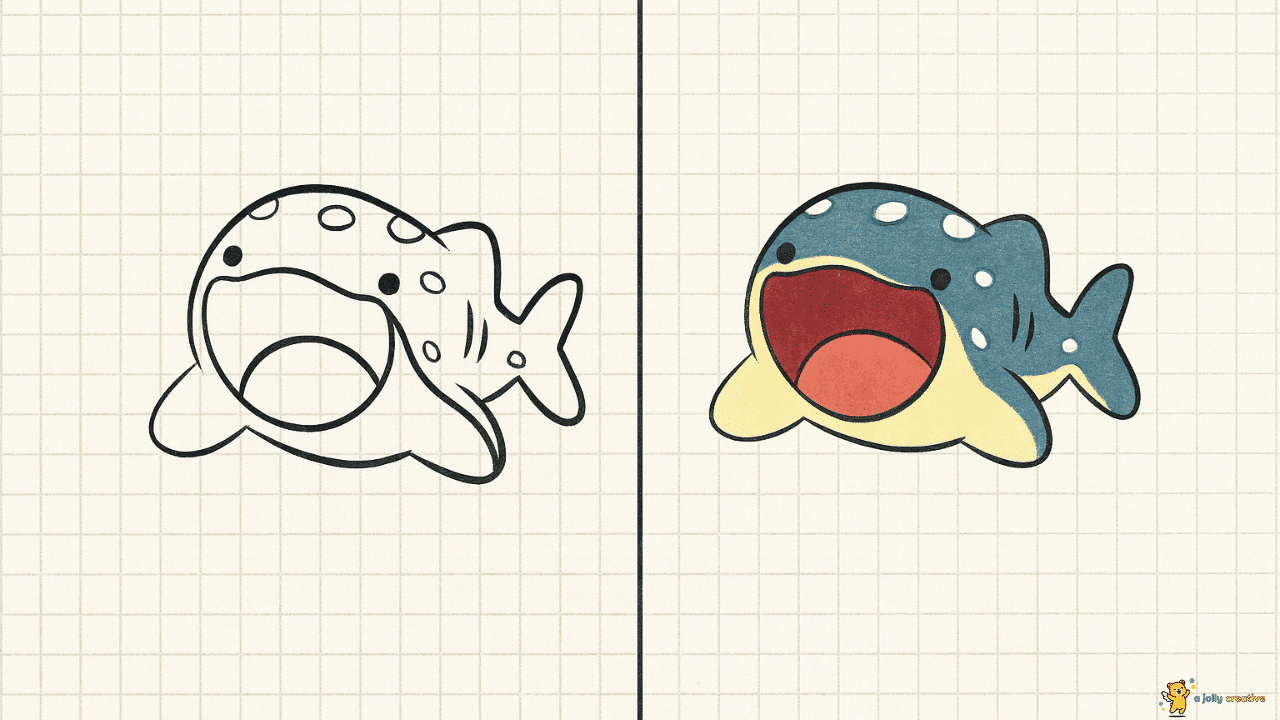
Spotted pattern simplification involves creating strategic dot arrangements that suggest the whale shark’s natural markings without becoming visually overwhelming.
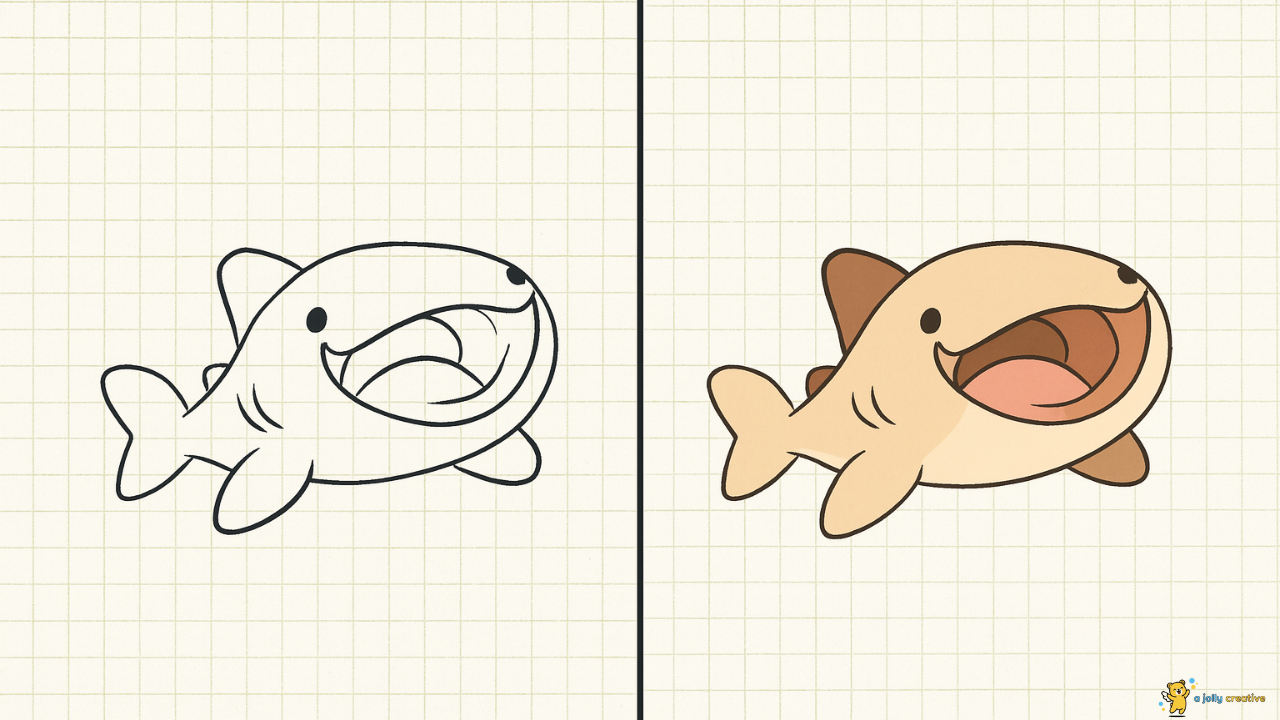
Focus on larger, more prominent spots near the massive head that gradually decrease in size toward the tail section. This natural size variation creates depth and visual interest while maintaining pattern recognition.
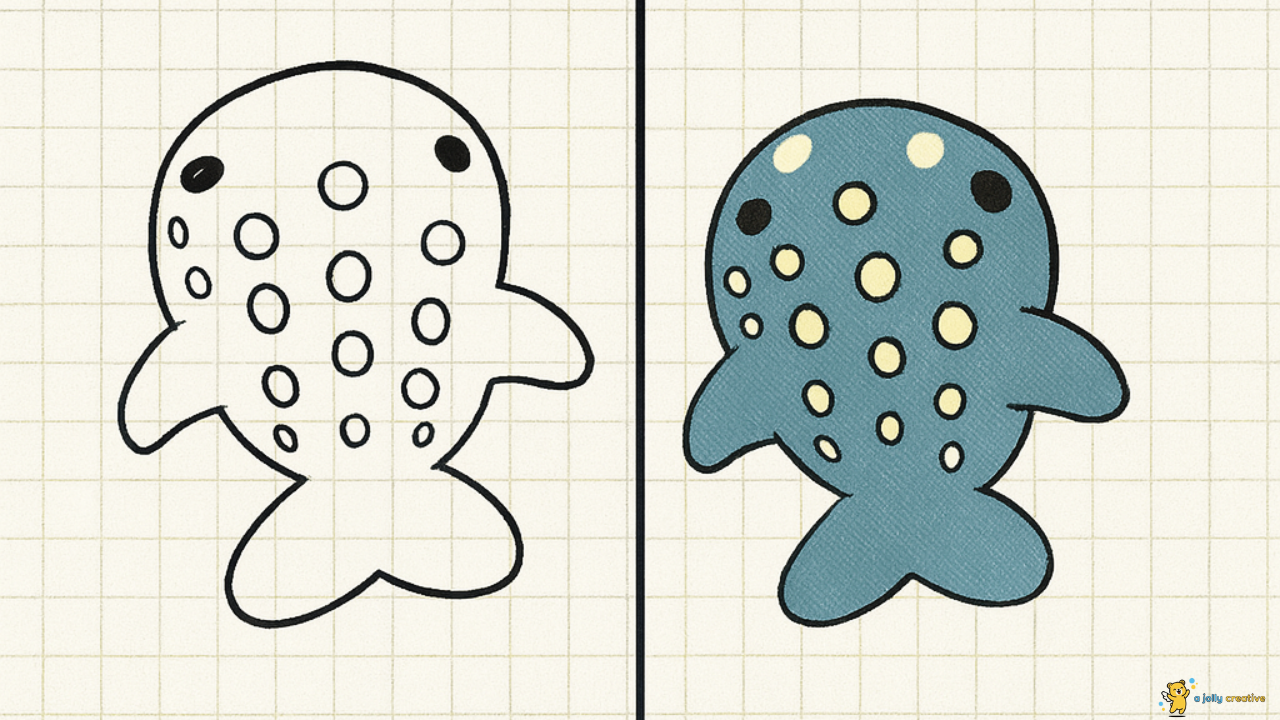
Gentle giant representation emphasizes the whale shark’s peaceful filter-feeding behavior and docile temperament toward humans. Their enormous mouths can stretch up to 5 feet wide, yet they feed exclusively on tiny plankton, small fish, and fish eggs through specialized filtering mechanisms.
Don’t miss our article on: 35+ Easy Hamster Drawing Ideas for Beginners
Final Thoughts
Your whale drawing journey continues far beyond these 15 foundational techniques, opening doors to endless creative possibilities and artistic growth.
Each whale sketch represents valuable practice and personal development in your expanding artistic abilities.
Progress celebration remains crucial for building artistic confidence and maintaining the creative motivation that fuels continued improvement.
Community sharing encouragement connects you with fellow whale enthusiasts and marine art lovers who appreciate ocean-themed creativity.
Online platforms provide excellent opportunities for sharing your whale creations and receiving supportive feedback from like-minded artists.
Consider exploring advanced marine biology resources, visiting aquariums for inspiration, or joining art communities that celebrate ocean conservation through creative expression and environmental awareness.
Hi, I’m Hazel Finch, a creativity enthusiast and writer at ajollycreative.com. I share easy drawing ideas, cozy gaming tips, and inspiration for creative hobbies. With a love for all things jolly and relaxing, I aim to help others discover the joy of creating in their own unique way. Follow my journey as I explore the world of art and play, one cozy activity at a time.

